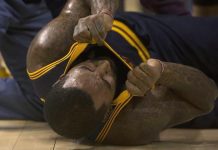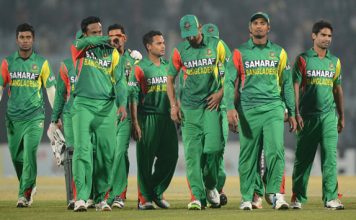MCC, the guardians of the Laws of Cricket, have taken steps to protect wicketkeepers from the sort of horrific eye injury that ended the career of South Africa’s Mark Boucher, by ratifying the use of tethers to limit the distance that that bails can travel when the wicket is broken.
Although eye injuries from flying bails are rare, they can often have devastating consequences, as Boucher in particular discovered in the opening match of South Africa’s 2012 tour of England.
Standing up to the stumps against Somerset at Taunton, Boucher was struck flush in the left eye when Gemaal Hussain missed a slog against the legspin of Imran Tahir, and suffered a lacerated sclera, the white outer layer of the eyeball. Despite a lengthy operation to save his sight, Boucher lost his lens, iris and pupil, and suffered permanent photophobia, or sensitivity to bright light.
“I had not worn a helmet but even if I had, it would not have avoided the accident,” Boucher said in an interview last year. “Helmets are designed for balls, not bails. My recommendation would be to somehow attach the bails to the stumps, by a light string.”
Two decades before his injury, the career of England’s Paul Downton was ended in a similar fashion when standing up to John Emburey against Hampshire at Basingstoke in 1990. In his case, he suffered an impact injury that partially shattered his lens, and altered his depth perception to such an extent that he retired six weeks into the following season to become a stockbroker. He still experiences blurred vision in his left eye.
MS Dhoni also suffered a near-miss, albeit as a batsman, during a T20 against Zimbabwe in Harare in 2016.
MCC’s response to these incidents has been an alteration to Law 8.3, following an approach from two companies – one from South Africa and the other from the UK – who have submitted designs for mechanisms that tether the bails to the stumps, without limiting their ability to be dislodged.
“If it prevents someone losing their eyesight, it’s got to be worth considering,” Fraser Stewart, MCC’s Laws Manager told ESPNcricinfo. “The companies involved are still working on their patents, so this is very much a work in progress, but what MCC have done is make such devices permissible in the Laws. After that, it is up to the governing bodies to allow for their use.”
Law 8.3.4 now reads: “Devices aimed at protecting player safety by limiting the distance that a bail can travel off the stumps will be allowed, subject to the approval of the Governing Body for the match and the ground authority.”
Only the UK version, designed by Augury Sports, has so far been seen in its physical form by MCC. The brainchild of Gus Kennedy, a former Oxford and Cambridge MCCU wicketkeeper, it comprises of two holes, drilled down into the off and leg stumps, and a tiny, lightweight ball, attached to a piece of cotton. The ensemble rests on a platform, so that there is no weight pulling on the bail, which is then able to travel no further than three inches when the stumps are put down.
“Keeping on the fringes of the first-class game highlighted to me the dangers of flying bails, as did the Mark Boucher injury,” Kennedy told ESPNcricinfo. “The risk of losing a Buttler/De Kock/Bairstow to an eye injury was enough to inspire me to put some thought into the design.”
Aside from the physical thrill of watching the bails flying through the air, there are few obvious drawbacks to the proposed innovation. Stewart concedes that adapting the mechanism for zing bails could be problematic, with their reliance on sensors to trigger the lights, while there may also be implications for run-outs on occasions when the stumps have already been broken.
Law 8.3.4 is one of a raft of new measures from MCC’s Laws Drafting Group, including tighter restrictions on the depth of bats and greater powers to curb poor on-field behaviour. These will come into effect on October 1, and constitute the first revised code since 2000.
































